Education Kit

TOUR DATES & VENUES
24 July – 20 September 2015
30 October – 6 December 2015
8 January – 6 March 2016
19 March – 8 May 2016
13 May – 3 July 2016
8 July – 28 August 2016
16 September – 13 November 2016
26 November 2016 – 19 March 2017
COUNTRY & WESTERN
Perc Tucker Regional Gallery, Townsville (QLD)
S.H. Ervin Gallery, Sydney (NSW)
Blue Mountains City Art Gallery (NSW)
Wagga Wagga Art Gallery (NSW)
Mornington Peninsula Regional Gallery (VIC)
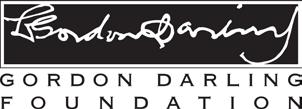
Orange Regional Gallery (NSW)
Cairns Regional Gallery (QLD)
Museum and Art Gallery of the Northern Territory (NT)
Country & Western: landscape re-imagined shows paintings, photographs, prints and sculpture by Indigenous and nonIndigenous Australian artists over the last twenty-five years.


FREE ACTIVITY BOOK AND EDUCATION KIT
A free Activity Book and Education Kit have been designed in response to this exhibition and targeted at primary and middle school students. Please ask for a copy from any of the galleries involved in the tour.
Cover image: Angelina George b. 1937 - 2015 Yungul Mangi Near Ruined City [detail] 2007 synthetic polymer paint on canvas 160 x 200 cm Purchased 2008, Museum & Art Gallery Northern Territory Collection Telstra National Aboriginal and Torres Strait Islander Art Award winning painting
Education Kit Activity Book
Contents: Country & Western 4 What is a Landscape? 5 Western Traditions of Landscape 6 Worksheet 1 8 The Role of a Curator 10 Worksheet 2 10 Adaptation 13 Worksheet 3 15 Identity & Representation 16 Connectedness & Collaboration 17 Displacement, Massacres & Dispossession 19 Key Terms 22
This Education Kit aims to provide information about a selection of artists and artworks featured in the exhibition and highlight some of the many themes that are associated with Australian landscape art. The Education Kit is intended to aid teachers and students in their enjoyment of the exhibition and as a means of encouraging individual and group responses to the art experienced. Included are suggested activities, discussion points and ideas for research incorporating various school curricula.
The exhibition shows paintings, photographs, prints and sculpture by Indigenous and nonIndigenous Australian artists over the last twentyfive years. All the artists who have made the works are in some way engaged with thinking about and expressing how the Australian land is experienced by the people who live here, and how this contributes to the sensibilities and identities of people who live in Australia.
The exhibition title Country & Western: landscape re-imagined itself says something about Australia’s history as it references both Indigenous and non-Indigenous artists. For thousands of years the art and culture of Indigenous people has described ‘Country’. Their art has informed and influenced the way the Australian landscape has been experienced by non-Indigenous ‘Western’ people and artists. The curator of the exhibition, Gavin Wilson, has set out to reveal and consider how these influences might have changed the traditions of Western landscape art and also, “search out common ground, (if any).”

4
Image: Mulkun Wirrpanda b. 1945 Dhuruputjpi North Eastern Arnhem Land Rakay 2013 natural pigments on bark 156 x 87 cm Collection of the artist
What is a Landscape?

A landscape picture shows a scene or view of the natural world. The landscape might be a picture of mountains, trees, rivers, valleys etc. Landscapes could be imaginary or they could be copied from real places. The land in Indigenous art describes a world view, the universe and its creation - it provided surfaces (rock, sand, earth, tree bark) for expression and the materials used to paint onto the bodies that inhabit it.

Researching the past western traditions of the landscape genre will introduce students to some ideas and ways of seeing the land that Australian artists inherited and that influenced their initial portrayal of the Australian landscape. Contemporary artists, like Imants Tillers (represented in this exhibition) appropriate this past and include it within the post colonialist commentaries implicit in many of his works.
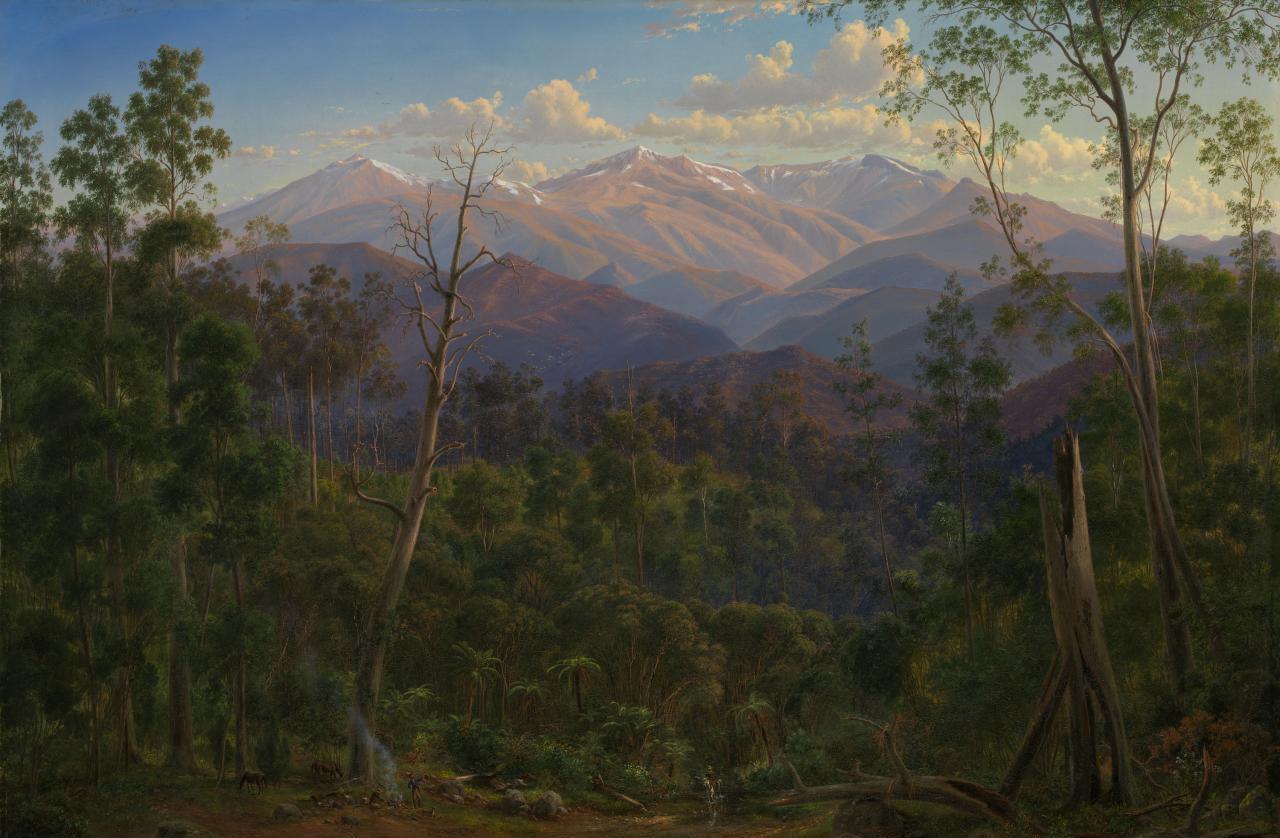
5
Image: Imants Tillers
b. 1950 Sydney, NSW Model of Reality 1989 oilstick, gouache, synthetic polymer paint on 90 canvas boards 228.6 x 381 cm
Purchased with funds from the Colin Hicks Caldwell Bequest, 1992 Collection: Art Gallery of Ballarat
Image: Eugene von Guérard Mount Kosciusko, seen from the Victorian border (Mount Hope Ranges) [detail] 1886 Oil on canvas 108 x 153 cm © National Gallery of Victoria
Image: Jeffrey Smart Cahill Expressway [detail] 1962 Oil on plywood 81 x 111 cm © National Gallery of Victoria
Western Traditions of Landscape

Landscape was depicted in Greek and Roman times, but was then seen mostly as backgrounds to narrative paintings rather than as a subject in its own right. In the 1700s, the interest in the natural world through exploration and ‘discovery’ saw the rise of landscape as a dominant genre.
Artists observed nature and the land through drawings, sketches and the use of devices like a camera obscura, which they then developed into final works in a studio. Working directly in the open air or En plein air to experience and describe the land became more common in mid-1800s by painters interested in capturing the effects of natural light. Working outside was made possible by the portability of easels and ‘ready to use’ paint in a tube.

Before photography; paintings, drawings and prints were a way of documenting and describing different parts of the world that were being visited by travellers and explorers. In the European Western art tradition, landscapes were often painted in a way that showed the natural world in an ‘ideal’ way - tidy and well ordered (even if it really wasn’t!) or aweinspiringly grand. Sometimes an artist would be paid to paint a landscape by a land owner, so they could have a view of the property they possessed documented and on display.
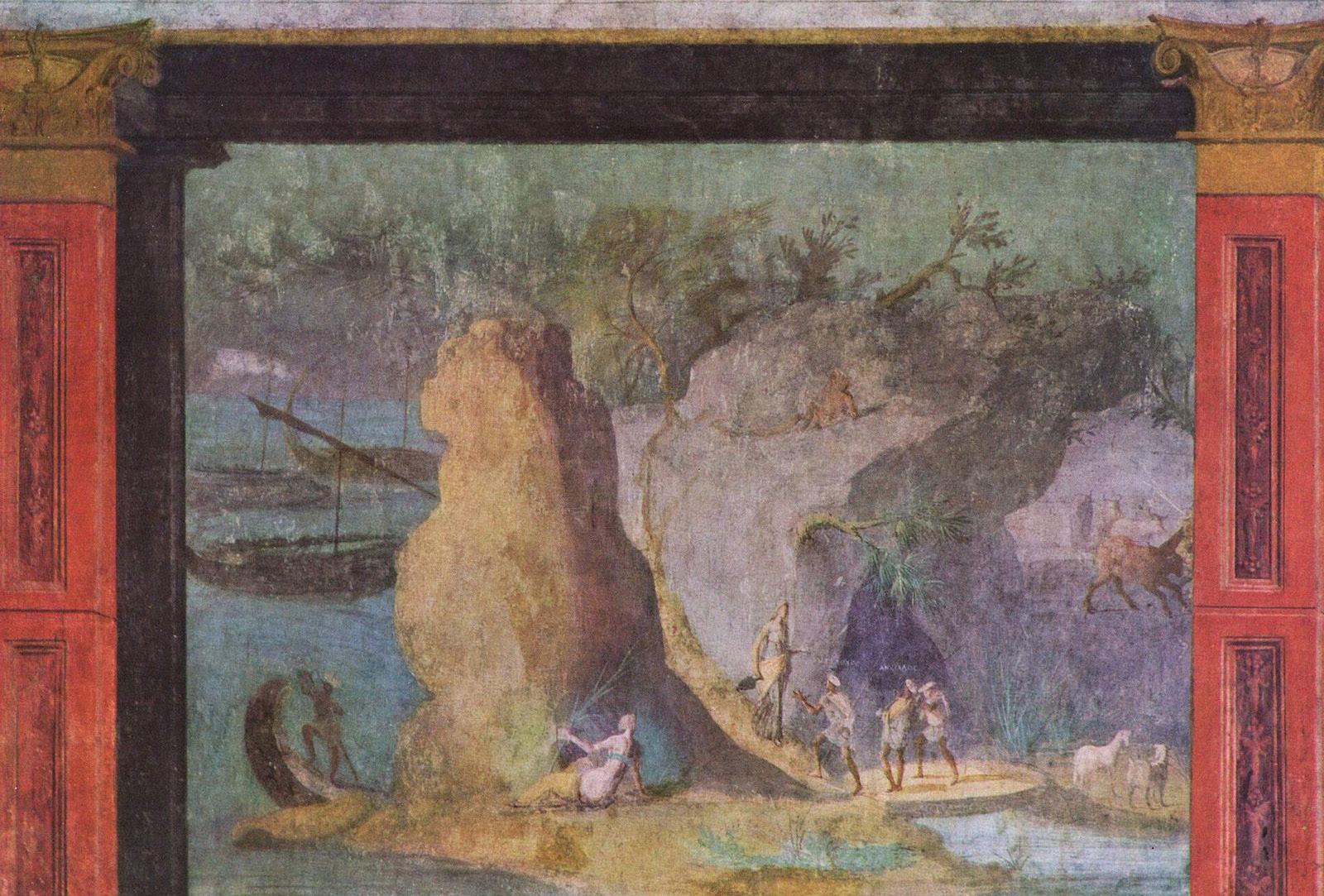
6
Image: An example of Roman narrative painting, Landscape to the Odyssey circa 60-40 BCE.
Image courtesy of Wikipedia commons
Image above: En plein air painting by Claude Monet, View of Antibes from the Plateau Notre-Dame, 1888
Image: Illustration of a periscope-style camera obscura used by artists in the field c. 1825
There is a long and important history of Chinese and Japanese landscape art which influenced Western landscape art, particularly in the late-1800s and early-1900s. Modernist Art drew hugely on learning about other cultures and their belief systems and ceremonies - seen primarily in the objects collected and displayed in western ethnographic museums. Modernism impacted on the development of a unique ‘Australian Art’ which looked at Australian experiences of land and culture as opposed to a European perspective.
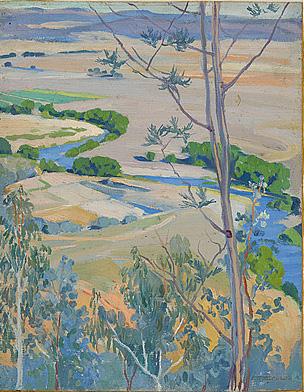

Ideas about individual expression, and challenging the boundaries of what art was and what it could be, contributed to an understanding of conceptual and spiritual ways of visual communication. Many Australian artists were able to learn from and embrace Indigenous art making practices and appreciate how individual and group connections to land and place are integral to belief and identity.

7
Image: Japanese landscape art. Ichiryusai Hiroshige’s 19th century woodcut of Waves Off the Satta Pass in Suruga Province from the set Fuji sanjurokkei, the Thirty-six Views of Mount Fuji
Published by Tsutaya Kichizo, 1858
Image: Australian Modernist Art. Hare in Trap by Sidney Nolan 1946. Ripolin enamel on composition board, 90.5 x 121.5 cm. © The Trustees of the Sidney Nolan Trust/Bridgeman Art Library
Image: Australian Modernist Art. Hilda Rix Nicholas Molonglo River from Mount Pleasant, Canberra 1927 Oil on canvas on board, 41 x 32 cm Acknowledgment: John Hindmarsh AM and Rosanna Hindmarsh OAM Fund 2013 100 works for 100 years Accession No: NGA 2013.235 Image rights: © Bronwyn Wright
Worksheet 1
Look around the exhibition and find an example of the following:
1. A painting which uses abstraction to describe the landscape
Artist name:
Title of work:
Write three words to describe the work you have selected:
List six colours that describe the chosen work: List six textures that describe the chosen work: List six emotions that describe the chosen work:
2. A lino cut print or wood engraving
Artist name:
Title of work:
What is the subject matter of the prints you have selected?
How do you think this lino cut print/wood engraving has been made?
8
3. A three dimensional work used in performance
Artist name:
Title of work:
What story is told when this work is worn and performed?
List the materials used to construct the work:
4. A video and a photograph from an aerial view point
Artist name:
Title of work:
How does aerial photography contribute to our understanding of human impact on the environment?
5. An Indigenous painting that tells a story
Artist name:
Title of work:
What narrative is being described in the painting?
Activity at School
Work in small groups to research one of the following ‘landscape’ topic areas:
1. European landscape painting in the 1700s. What was depicted? How was it depicted (describe the subject matter, the visual devices used, materials and techniques)? Who were the works for?
2. Australian landscape painting 1950-1990. Explain how the artists and the works produced were/have been influenced by ‘movements’ in art history.
3. Papunya Tula (1971). Is ‘Aboriginal Art’ a western construct? Produce and present ideas for a series of landscapes that express what it means to you to be Australian.
9
The Role of a Curator
A person who envisages, puts together, looks after and oversees an exhibition is called a Curator. The word originates from the Latin, ‘to take care’. Traditionally a Curator would manage and have specialist knowledge about a collection of objects belonging to a museum, gallery, library or private estate. A Curator will often research and write interpretive information (didactic) for audiences, for example, the information panels or wall text that accompany objects on display in a museum or gallery, a documentary or lecture, an essay or introduction in a catalogue or brochure about a particular exhibition.
Often a curated exhibition will give form to a particular theme or idea. List some exhibitions that you know of or have visited that have a theme.
Explain the Curator’s concept of Country & Western: landscape re-imagined.
Worksheet 2:
Curate your own ‘mini’ exhibition from this show. Select six works that best describe your experience of this exhibition. Write the details of your selected works in the table below:
10
Artist Name Title of Work Date Material Used Dimensions (H X W)
Give your exhibition a title and explain its concept.
There is much that goes on behind the scenes in exhibiting art for the public to look at and experience. Think about ‘behind the scenes’ activities and the people involved in presenting an exhibition in a public gallery. Consider how the artworks have been arranged and the way the works are presented in the exhibition.
Who decides where and how the art works are hung and placed?
How does the lighting and the colour of the walls affect the works on display?
Are there specially designed display cabinets? Who makes these?
Are there any audio visual presentations?
11
What information or didactic is available to describe the works? Who writes it? How is it presented?
Is there a catalogue? Is there anything to engage children with the exhibition?
What publicity have you seen (or do you think there may be) to advertise the exhibition? Who designs this?
This exhibition is going to travel to seven other galleries. How do you think this is organised and who is involved?
Activity at School
Present your idea for curating a mini exhibition based on your visit to Country & Western: landscape re-imagined to the class. Prepare and deliver a short talk about one of the works you selected for your exhibition to the class. Explain your choice and describe your responses to it.
12
Adaptation
Originally Indigenous cultural practices employed natural materials - the subject matter was itself the material used. Adaptation has opened up many new areas for traditions to develop and continue to be expressed. The exhibition includes the work of printmakers in Torres Strait Island who have built on a cultural heritage of relief carving to master the art of relief printing using linocut.

Identify how corrugated iron and milk tins were used in the childhood memories of print artist Tommy
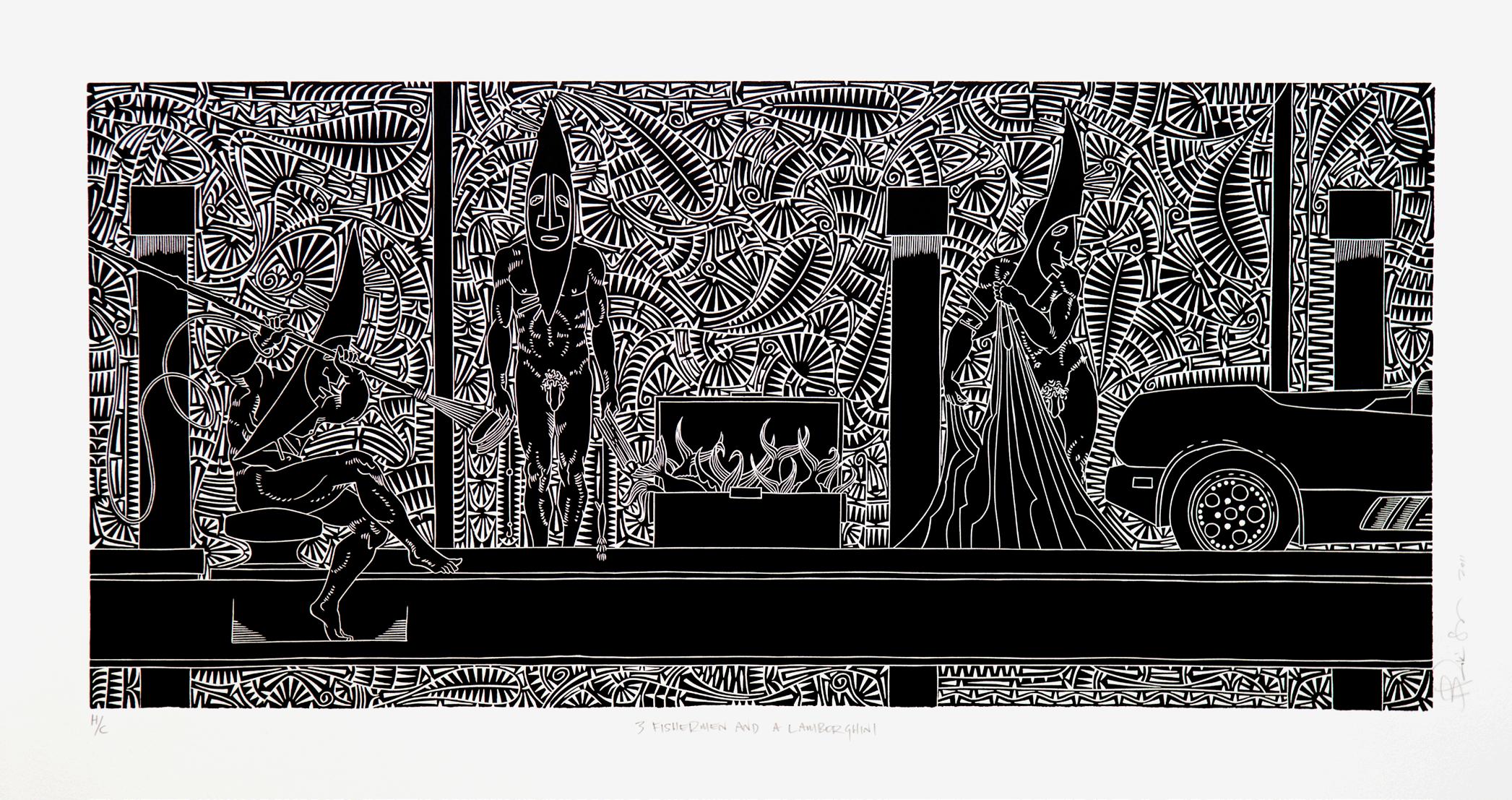
13
Look above at the print by Brian Robinson 3 Fishermen and a Lamborghini. Describe the story that is being illustrated between past and present.
Brian Robinson b. 1973 Waiben (Thursday Island) 3 Fishermen and a Lamborghini 2012 linocut printed in black ink from one block on BFK Rives white 300gsm 63.5 x 110 cm edition of 30 Edition printer Carolyn Crain, collection of the artist
Tommy Pau b. 1967 Waiben (Thursday Island) Milk Tin Trains 2013 linocut printed in black ink from one block 56.5 x 76 cm edition of 10 printed by Elizabeth Hunter, collection of the artist
Shane Fitzgerald
Pau.
Image:
Image:
Photo:
Torres Strait Islander artist Ken Thaiday Snr. has developed the ritualistic use of masks and headdresses into dance machines worn by male dancers as they bring to life the sculptural forms through performance. Wood, shell, fiber and natural pigment is now replaced by the use of plywood, plastic piping, and nylon fishing line and enamel paint to construct and decorate these ancient characters.
Artist Ricky Maynard spent time in the late 1980s studying at the International Centre of Photography in New York, USA and was particularly influenced by the story telling devices employed by early social documentary photographers like Mary Ellen Mark, Walker Evans, Eugene Smith and the new aesthetic of the f/64 group including Edward Weston and Ansel Adams.
What is documentary photography?
How has Ricky Maynard used landscape as social documentary?
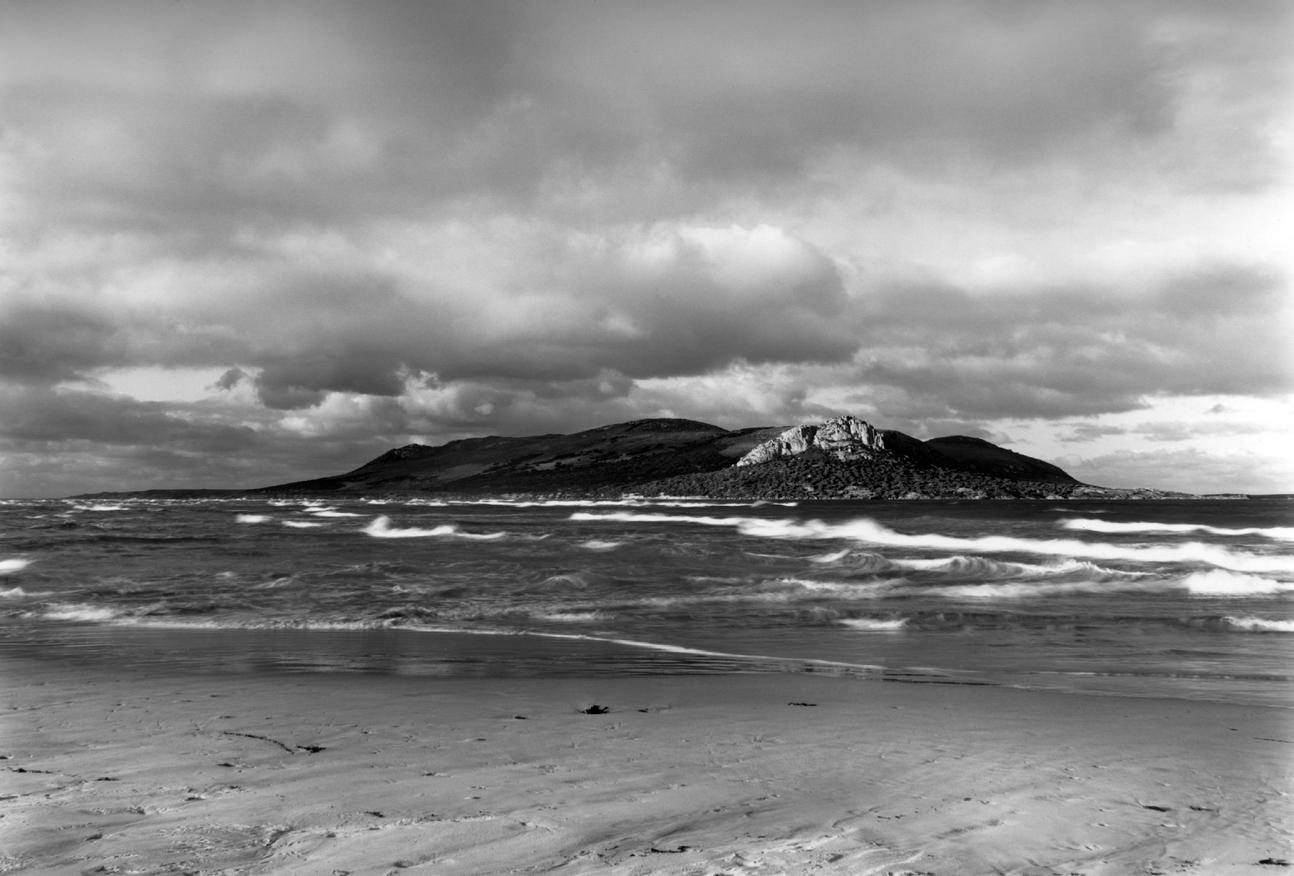
Activity at School
1. Research and present examples of the work of two of the early documentary photographers mentioned above.
2. The curator of Country & Western: landscape re-imagined refers to the Yolngu artists from Arnhem Land and their adaptation of using found objects and materials discarded by mining companies like rubber conveyor belts, PVC piping, roof insulation to continue to tell their stories. Research and find examples.

14
Image: Ken Thaiday Snr.
b. 1950 Erub (Darnley Island) Black bamboo Hammerhead Shark headdress (small) 2010 bamboo, marine ply, fishing line and eagle feathers 52 x 43 x 40 cm
Cairns Regional Gallery Collection, Purchased with the funds from the E Robert Hayles and L Hayes Charitable Trust and the John Christopher Pascoe Memorial Charitable Trust Managed by Perpetual, 2010
Photo: Michael Marzik
Image: Ricky Maynard b. 1953 Launceston, TAS The Spit 2005 from the series, Portrait of a Distant Land, 2005 black and white silver gelatin print 42 x 50.5 cm © Ricky Maynard Courtesy of the artist and Stills Gallery, Sydney
Worksheet 3
Find examples in Country & Western: landscape re-imagined of figures in landscape.
For Example:
Ricky Maynard, Broken Heart 2005
Jo Bertini, Through Desert Eyes 2014
Euan Macleod Present 2008
Tim Johnson’s portrait of Clifford Possum Tjapaltjarri 2002
Tracy Moffatt’s Invocations #2 2000
Which shape/orientation has been used - ‘portrait’ or ‘landscape’ - in your selected works?
How do the genres of ‘portraiture’ and ‘landscape’ overlap?
Use the portrait orientation box on the right to a draw a ‘landscape’ that in some way describes you.
15
Identity & Representation
Tracey Moffatt is a contemporary Australian photographer and film-maker. Her creative practice incorporates elements of glamour, fantasy and pop culture that challenges the traditional representation of what it is to be an Indigenous Australian. Growing up in an Anglo-Saxon foster home as a child of Indigenous heritage, Moffatt’s upbringing was absent of any traditional teachings or reference to her cultural background. Instead, Moffatt was highly influenced by the western ideals portrayed in magazines, films and on television. Her work breaks away from the stereotype of what it is to be “Aboriginal”. Moffatt questions the notion that being Indigenous Australian means being devoid of any other influence, culture or identity
Tracey Moffatt’s Invocations is a series of intricate silkscreens produced from constructed tableau photographs. Moffatt collaborated with designers in order to manufacture stage sets, posing models within these constructed environments to photographically capture the choreographed scene. Using up to 25 silkscreens per image, Moffatt layered each print using such subtlety in colour that the images are imbued with a seductive dream-like quality that is often attributed to paintings. The series Invocations draws inspiration from one of Moffatt’s own dreams and explores what she refers to as, “the dark underworld that we all have… it’s about the murk in all of us, the subconscious” (Tracey Moffatt interviewed by Bruce James, ABC Arts, 09/01/2001). In this way, Moffatt explores her own form of The Dreaming; what underpins her identity and relationship with both the spiritual and physical worlds.
Moffatt incorporates references within her series to fairy tales, the Brothers Grimm, witches, spirits, Hitchcock’s movie The Birds and Goya paintings. Her images, while suggestive of post-apocalyptic dreamscapes, suggest a form of reminiscence; a blurred memory of the past. In this way, Moffatt builds landscapes and creates narratives within each image that explore connections with the land through past, present and future notions of collective memory and recollection.

Activity at School
1. In your own work explore the idea of ‘tableau’ to create a dreamscape. Use collage, montage and/or Photoshop.
2. What media and techniques did surrealist artists explore to visualise the subconscious.
3. Discuss the idea of ‘identify’. What do we mean by this term? Is the idea of ‘identity’ something you think of as being fragmented with many aspects (some opposite to each other) or something complete and compact?
16
122
Image: Tracey Moffatt b. 1960 Brisbane, QLD Invocations #2 2000 photo silk screen
146 x
cm
Courtesy of the artist and Roslyn Oxley9 Gallery, Sydney
Connectedness & Collaboration
Born in England, John Wolsely immigrated to Australia in 1976 where he describes feeling “immediately at home”. Since then, he has travelled extensively around Australia from the floodplains of Arnhem Land to the mountains of Tasmania. Wolsely believes that our bodies are connected with the land; that we are part of one giant living and breathing organism. He believes that nature sustains us and that mankind has become so overly obsessed with artificial landscapes that we no longer take time to listen and connect with the land. In this way, he views himself as both an artist and an amateur scientist; ever concerned with how things work at a minute detail. His artworks are a contemporary nod to the practices of both conservation and husbandry
Wolsely uses techniques such as collage, frottage, grattage, nature printing, and direct kinetic contact to make marks on paper. It is this element of hands-on collaboration that makes Mother Nature a contributing artist in his work. Like pulling the back off a watch and observing how the cogs spin, Wolsely’s artworks unveil the inner workings and energy of nature. Wolsely’s work can been seen as both philosophy and methodology based; his work being as much performative as it is about process. For example, working frenetically Wolsely employs “kooky” mark making practices such as inking up the dead bodies of animals to essentially “print” their image upon a surface. He also uses his body to imitate movement; painting with mud in sweeping motions to create subtle lapping of a riverbank.

Collaboration between western and Indigenous artists has resulted in new works and practices. Look at the work of Tim Johnson. Papunya Tula Artists Pty. Ltd. is an artist cooperative formed in 1972. It is owned and operated by Aboriginal people who were brought together from their homes from many parts of the Western Desert of Australia. Traditionally their cultural stories and ceremonies were visualised through a process of dot marks painted onto the body with natural pigments, or drawn into the sand. As a result of their displacement Papunya artists adjusted to using paint and canvas as a means of continuing to relate their past and their identity. The works produced gave rise to the distinctive style of ‘dot painting’ that was to be recognised and made popular as ‘Aboriginal art’ from that time. It also influenced many artists’ understanding and relation to the Australian landscape.

17
Image: John Wolseley b. 1938 Somerset, England Yirrinanin, Mawuka and Buwakul 2013 woodcut from 3 blocks 90 x 120 cm
Printer John Wolseley, collection of the artist © John Wolseley / Licenced by Viscopy, 2015
Image: Tim Johnson b. 1947 Sydney, NSW Faraway 2013 synthetic polymer paint on linen 150 x 120 cm Winner of Paddington Art Prize 2013 Collection of Simon Chan
In the 1970s, Sydney born artist Tim Johnson practiced performance art, conceptual art and photography. He started visiting Papunya in the 1980s and was invited to assist with dotting in some of the paintings being produced by Indigenous members of the group. He collaborated with over 30 works in the next 20 years and was given permission by senior Indigenous artists like Clifford Possum Tjapaltjarri to borrow and use some aboriginal designs in his own work. This permission was granted on the condition that the custodianship of the story being referred to in the artwork remained with its Aboriginal owner. His painting of Clifford Possum Tjapaltjarri combines portraiture and landscape. It depicts the land together with symbols representing the traditions and life of his subject. In Faraway, 2013, Johnson uses a variety of mark making developed from his work with Papunya; photographic images; techniques using stamp and stencil and symbols denoting Buddhist and Tibetan culture and beliefs.

Mulkun Wirrpanda, a Yolunga elder, has collaborated with John Wolseley. Their collaborative work combined Wirrpanda’s concern that young people’s health was suffering as a result of fast food with Wolseley’s observations and depictions of the environment and nature’s resources. Rakay (water chestnuts) grow in the flood plains of Arnhem Land and could easily provide a healthier (traditional) alternative food to eat. The results of the artists working together shown in the exhibition are a bark painting and a wood block print.
Activity at School
Collaborate with one or more people in your class to create a ‘landscape of food(s)’ grown and produced locally to where you live. Think of the media and techniques you would like to explore (print, photography, papier mâché, found objects, collage, paint, stencil) and the end result (concertinaed art book, animation, mural etc.).
Agree on how the collaboration will work and how you have best utilised each other’s strengths and interests!
18
Image: Mulkun Wirrpanda b. 1945 Dhuruputjpi North Eastern Arnhem Land Rakay #2 2013 woodcut from 2 blocks 144 x 100 cm
Printers Gibson Gill and John Wolseley from the Midawarr Series collaborative prints with John Wolseley Collection of the artist
Displacement, Massacres & Dispossession
Paddy Bedford, also known as Goowoomji, was a contemporary Indigenous artist. Bedford took up painting in his senior years after a lifetime working as a stockman in the North-most region of Western Australia. Bedford belongs to the Gija people of the East Kimberly and was a senior lawman and elder of his mob. Bedford’s work echoes his people’s history; marred by stories of violence, massacre and forced displacement.

Paddy Bedford was born around 1922 on a property which bestowed him his surname – Bedford Downs Station. As was practice at the time, Paddy also inherited his given name from the station master, Paddy Quilty. Quilty was rumoured to have been involved in a massacre of Indigenous people just a couple of years prior to Bedford’s birth.
This painting recalls the Bedford Downs Massacre, an event that had a profound impact on the Gija people. Reportably, the massacre was a retaliation committed by white station hands after a group of Gija men were tried for spearing a milking cow. They were force-fed strychnine and then either beaten or shot to death. Many of Bedford’s relatives were murdered in this massacre. Bedford Downs Massacre, 2001, is painted from the perspective of Bedford’s ancestral spirits. Looking down upon the massacre site, the spirits see the two young girls (represented by the two red dots on the left side of the canvas) hiding in the spinifex witnessing the horrendous incident. The girls would live to recount their story. Bedford, by visually retelling this story, exposes the cruelty of men like Quilty and the appalling way in which Indigenous people were treated upon their own land.
Many of Paddy Bedford’s paintings were originally produced to be used in performances with dance music and song which told stories about the people of East Kimberly and their histories.
19
Image: Paddy Bedford
b. c. 1922 - 2007 Gija Bedford Downs Massacre 2001 ochre and pigment with acrylic binders on Belgian Linen 150 x 180 cm
The Corrigan Collection
Ricky Maynard is an Indigenous Tasmanian documentary photographer. His work deals with the significant sense of loss and dispossession felt by Aboriginal Islanders. Maynard’s extended family escaped extinction in Tasmania by relocating first to Cape Barren Island in the Bass Strait in the mid-1800s, then finally settling on Flinders Island. Maynard revisits sites of former injustices; re-invigorating landscapes scarred by past injuries and transforming them in to places of recollection and contemplation.
Maynard’s work addresses the significant emotional connection between history and place. Portrait of a Distant Land uncovers and examines the absence and misunderstandings present around the telling of Tasmanian Aboriginal people’s stories. In his work Maynard attempts to create ‘a combination of a very specific oral history as well as an attempt to show a different way of looking at history in general’ by using historical excerpts and personal quotes alongside his photographs.
Maynard’s use of a documentary-style aesthetic addresses the genre’s underlying authority as a vehicle for “evidentiary” truth telling. Using black and white film, his images are devoid of colour, suggesting an absence, or a feeling of something missing. Maynard combines social, historical and personal narratives to fill this absence. Maynard’s black and white photographs in Portrait of a Distant Land revisit the locations where the Palawa people of Tasmania were forcibly taken to the mainland and sent into exile.
Look above at The Healing Garden, Wybalenna, Flinders Island, Tasmania 2005 and answer the following questions on the opposite page. The photograph shows a white picket fence surrounding a thicket of trees. The trees stand as a memorial to a massacre of an Indigenous group that occurred on that site.

20
Image: Ricky Maynard b. 1953 Launceston, TAS
The Healing Garden, Wybalenna, Flinders Island, Tasmania 2005 from the series, Portrait of a Distant Land, 2005 black and white silver gelatin print 34 x 52 cm
© Ricky Maynard Courtesy of the artist and Stills Gallery, Sydney
How do you feel when you look at the photograph? Why do you think you feel this way?
Maynard shoots his photographs using black and white silver gelatin film. Look at the tonal range in this photograph. Find and describe the darkest and lightest areas of the photograph?
Given the underlying narrative how could these dark and light areas be interpreted? How do you think the reading of this image would change if the photographs were taken in colour?
Activity at School
Research the history of the Indigenous custodians of the land where you live. Record some of the stories, the main characters described and identify some of the sites referred to.
Work in groups to identify a place local to your school or where you live, which has a story or history. For example, a site which was once a playground/park now developed into something else. Consider different ways in which you might document the site and its history (video, music, poem, drawing, print, photographs.)
21
Key Terms:
Anglo-Saxon: a person of English ancestry
Aerial view: looking down from above either from a high geographic point, building or airplane
Audio visual: the use of sound and image, for example film, TV, projector using presentation software etc.
Authority: an accepted source of information
Exhibition catalogue: a document or record of the contents of an exhibition, including technical information about each item. Often accompanied by images of the works and essay(s) or introduction by the curator and/or specialists in the field
Camera obscura: an optical device that led to photography and the photographic camera. The device consists of a box or room with a hole in one side
Collaborate: to work jointly with others or together, especially on an intellectual endeavour
Collage: (French: ‘to glue’) a visual art technique where the artwork is made by assembling different forms. Collage commonly includes magazine and newspaper clippings, bits of papers, sections of other artwork or texts, photographs and other found objects, all glued to a piece of paper or canvas
Concept: a thought or idea, often formed from experience or from developing other existing concepts
Curator: originally someone who takes charge and cares for something. An exhibition curator is a person who selects content and manages its presentation
Denote: to indicate or describe the literal qualities of something as opposed to ‘connotation, which deals with possible implied meanings
Didactic: an information panel in an exhibition
Dispossession: the wrongful, non-consensual expulsion or removal of a person from his or her property by trick, compulsion, or misuse of the law, whereby the violator obtains actual occupation of the land
En plein air: French for in the open air, the act of drawing or painting outside
The Dreaming: the term does not have a direct translation to express the complex Aboriginal spiritual concepts to white people. “ ‘The Dreaming’ or ‘the Dreamtime’ indicates a psychic state in which or during which contact is made with the ancestral spirits, or the Law, or that special period of the beginning.”
Mudrooroo, Aboriginal writer
Frottage: French for “rubbing”, in visual arts, it is a technique of obtaining an impression of the surface texture of a material, such as wood, by placing paper over it and rubbing it with a soft pencil or crayon
Genre: a category or style, for example music can be defined as ‘pop’, ‘indie’, ‘classical’ etc.
Grattage: a technique in painting in which (usually wet) paint is scraped off the canvas
Identity: a person’s idea and expression of their own (self-identity) and others’ individuality or group associations (such as national identity and cultural identity)
Husbandry: the management of home and land including financial affairs
Massacre: a specific incident which involves the deliberate slaughter of people
Modernism: a philosophical movement that, along with cultural trends and changes, was the result of wide-scale transformations in Western society in the late-1800s -1900s. Among the factors that shaped Modernism were the development of modern industrial societies and the rapid growth of cities, followed then by the horror of World War I
22
Modernist Art: art produced from the late-1800s and the development of art that was not preoccupied with exact representation and abstraction, expression and ideas about art for art’s sake
Oral History: a method of gathering, preserving and interpreting the voices and memories of people, communities, and participants in past events.
Papunya Tula: is an artist cooperative (Papunya Tula Artists Pty. Ltd.) formed in 1972 that is owned and operated by Aboriginal people from the Western Desert of Australia

Philosophy: the study and questioning of complex but everyday issues. For example: What is good and what is bad? What is reality? What is ‘beauty’? How do we think and how do we develop meaning through language systems?
Portraiture: the representation of a person’s head/face/shoulders often as a means of describing and expressing the person’s mood, personality or status
Representation: (in art) non-verbal two-dimensional or three-dimensional rendition or interpretation of something that is recognised as being a close likeness to the thing that has been seen, remembered or imagined
Tableau: a scene that is created and staged to show an event in history or story using props and actors/ models who are dressed in costumes and who do not speak or move
Narrative: a story or report of connected events, actual or imaginary, presented in a sequence of written or spoken words, or still or moving images
Surrealism: a style of art and literature that explores the subconscious and non-rational
Tonal range: the difference between the maximum (highlights) and minimum (shadows) levels of light
23
Image: John Gollings
b. 1944 Melbourne, VIC Mount Newman Mines Overburden 2010 ink jet print on Hanemuhle Baryta photo rag 74 x 110 cm
Collection of the artist
24

























